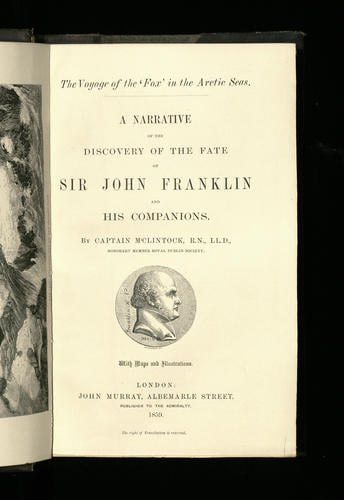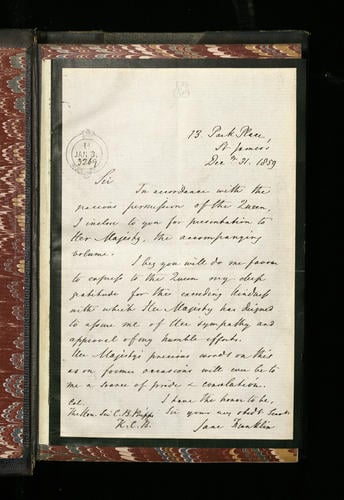-
1 of 253523 objects
The Voyage of the "Fox" in the Arctic seas : a narrative of the discovery of the fate of Sir John Franklin and his companions / by Captain M'Clintock. 1859
23.3 x 15.6 x 4.1 cm (book measurement (conservation)) | RCIN 1024361

Sir Francis Leopold McClintock, Admiral (1819-1907)
The Voyage of the "Fox" in the Arctic seas : a narrative of the discovery of the fate of Sir John Franklin and his companions / by Captain M'Clintock 1859

Sir Francis Leopold McClintock, Admiral (1819-1907)
The Voyage of the "Fox" in the Arctic seas : a narrative of the discovery of the fate of Sir John Franklin and his companions / by Captain M'Clintock 1859


-
This book contains the printed account of Captain Francis McClintock's expedition with the yacht Fox, which was outfitted to discover the fate of the lost expedition of Sir John Franklin. It was presented to Queen Victoria by Franklin's widow, Jane, in December 1859.
In 1845, Sir John Franklin set sail from Britain with a crew of around 120 men on board two ships, HMS Terror and HMS Erebus. The intention was to complete the charting of the Northwest Passage, a route which traverses the Canadian Arctic between the Atlantic and Pacific Oceans. After the refusal of Sir James Clarke Ross to lead the expedition, Franklin was selected by the Admiralty and equipped the ships with the latest steam technology so that they could move under their own power.
The ships reached Canada in the late summer of 1845 where they were seen by a whaler in Lancaster Sound, the entrance to the Parry Channel, on 26 July. This would be the last time the expedition was seen by Europeans. The ships became trapped in ice just off King William Island in September 1846, forcing Franklin and his crew to land on the island. Franklin died there in July 1847 and the remaining crew attempted to walk toward the mainland in the hope of reaching civilisation. No one made it back to the nearest outpost.
Not hearing any news as to the fate of the expedition, Franklin's wife, Jane, petitioned the Admiralty to outfit another to find out what had happened to her husband. This expedition left London in 1848 and a reward of £20,000 was issued for whoever found Franklin. This, and several other voyages in the 1850s, failed to find much concrete evidence of what had happened. In 1854, an overland expedition led by John Rae uncovered some tantalising information from Inuit who told him of the sighting of a party of men that had died of starvation nearby. Rae was also able to acquire some artefacts that were indeed from Franklin's crew and uncovered evidence that the party, in their desperation, had resorted to cannibalism. This news was shocking to the Victorian public, and Rae's reports were condemned.
In 1857, Francis McClintock headed a new search on board the yacht Fox, paid for by public subscription (including a large sum of money from Lady Franklin). After spending two winters in the Arctic, McClintock discovered the fate of Franklin's expedition. He encountered a group of Inuit who told him about a group of "white people who were starved upon an island" and others who stated that although they had not seen the crew they had "seen their bones upon the island where they died" while other men had been buried by their compatriots. Other Inuit then informed him of seeing two ships trapped in the ice and led him to the skeleton of a man who was identified as a member of the crew.
At the same time, a sledge party uncovered the final communications made by Franklin's men; hastily written notes describing the fate of the ships, of Franklin and of the decision by the remaining men to attempt to reach safety. These discoveries and the artefacts acquired during the voyage supported Inuit statements, and gave a date to the death of Franklin. The expedition returned to London in September 1859 and McClintock was knighted for his service. The wrecks of Erebus and Terror were finally discovered, close to their last reported locations, in 2014 and 2016.Provenance
Presented to Queen Victoria by Jane, Lady Franklin on 31 December 1859.
-
Creator(s)
(publisher)Acquirer(s)
-
Measurements
23.3 x 15.6 x 4.1 cm (book measurement (conservation))
Category